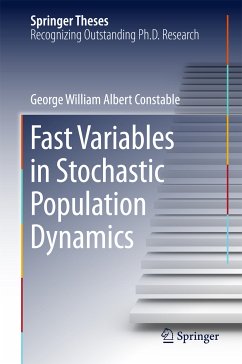
Extended Abstracts Spring 2013 (eBook, PDF)
Complex Systems; Control of Infectious Diseases
Redaktion: Corral, Álvaro; Massucci, Francesco; Korobeinikov, Andrei; Guerrero, Pilar; Font-Clos, Francesc; Deluca, Anna
Versandkostenfrei!
Sofort per Download lieferbar
56,95 €
inkl. MwSt.
Weitere Ausgaben:

PAYBACK Punkte
28 °P sammeln!
The two parts of this volume feature seventeen and six extended conference abstracts corresponding to selected talks given by participants at "Joint CRM-Imperial College Workshop in Complex Systems" and "Emergence, Spread and Control of Infectious Diseases" respectively, both held at the Centre de Recerca Matemàtica in Barcelona in spring 2013. Most of them are short articles giving preliminary presentations of new results not yet published in regular research journals. The articles are the result from a direct collaboration among active researchers in the area after working in a dynamic and ...
The two parts of this volume feature seventeen and six extended conference abstracts corresponding to selected talks given by participants at "Joint CRM-Imperial College Workshop in Complex Systems" and "Emergence, Spread and Control of Infectious Diseases" respectively, both held at the Centre de Recerca Matemàtica in Barcelona in spring 2013. Most of them are short articles giving preliminary presentations of new results not yet published in regular research journals. The articles are the result from a direct collaboration among active researchers in the area after working in a dynamic and productive atmosphere. Almost everything that is interesting and important for society is complex; here, examples scattered across science are presented in order to illustrate the cross-disciplinary richness of state-of-the-art complex systems research: fracture avalanches and rain showers that mimic earthquakes; highly organized graphs that account for processes in neural networks, metabolic networks, food webs, or language; models for DNA dynamics; or statistical methods to test complexity in the form of structure along many different scales. The mathematics is put to work for the modeling of the real system, and the models are kept at a minimum level to allow the understanding of the essentials of the real system. The book is intended for established researchers, as well as for PhD and postdoc students who wish to learn more about the latest advances in these active areas of research.
Dieser Download kann aus rechtlichen Gründen nur mit Rechnungsadresse in A, B, BG, CY, CZ, D, DK, EW, E, FIN, F, GR, HR, H, IRL, I, LT, L, LR, M, NL, PL, P, R, S, SLO, SK ausgeliefert werden.













